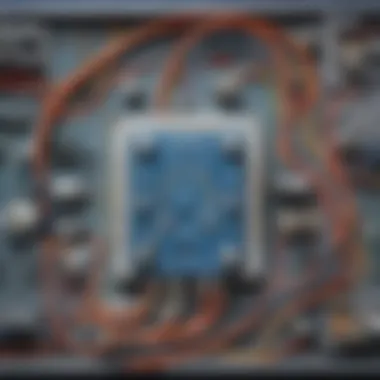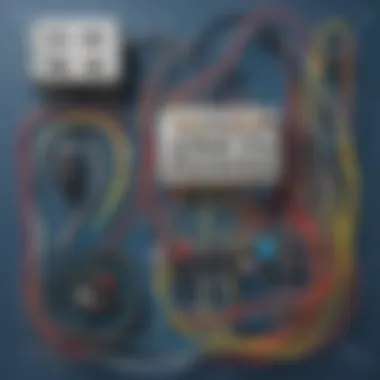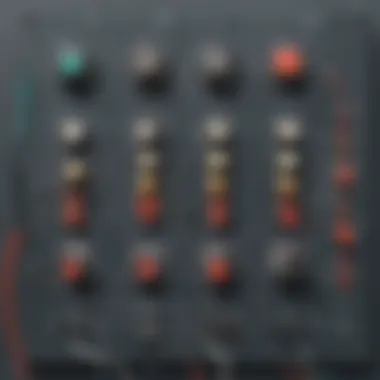Comprehensive Guide to Building an Electric Circuit for Young Science Enthusiasts


Science Fun Facts
Electricity is the flow of electrons through a conductive path. Did you know that lightning is a natural form of electricity created during thunderstorms? It can carry a tremendous amount of energy!
Discover the Wonders of Science
Exploring Various Scientific Concepts Today, let's delve into the concept of conductivity. Conductivity is a material's ability to allow the flow of electrical current. Metals are excellent conductors due to their atomic structure, allowing electrons to move freely.
Educational Videos and Animations To better understand conductivity, check out Lab Littles' animated video explaining how electrons move in conductors and insulators. The visual aid can clarify this fundamental concept in a fun and engaging way.
Interactive Learning Tools Take your learning further with interactive simulations that demonstrate how electrical circuits work. These hands-on tools allow you to build virtual circuits, test different components, and observe the flow of electricity.
Real-Life Applications of Science Did you know that the wiring in your house is a complex network of circuits? Understanding how to create and maintain electrical circuits is crucial for ensuring the safety and efficiency of your home's electrical system. Stay tuned to explore more real-life applications of science!
Science Quiz Time
Interactive Quizzes Are you ready for a challenge? Test your knowledge of electricity with our interactive quiz! From basic circuit components to understanding circuit symbols, this quiz will put your science skills to the test.
Multiple Choice Questions Choose the correct answer: What does a switch do in an electric circuit? A) Stops the flow of electricity B) Allows the flow of electricity C) Regulates the voltage D) None of the above. Select your answer and uncover the mysteries of circuitry!
Brain Teasers and Puzzles Sharpen your critical thinking skills with brain teasers related to electric circuits. Can you solve the puzzle of connecting all the wires to light up the bulb? Challenge yourself and have fun with brain-teasing activities!
Learning Through Gamification Embark on a learning adventure with gamified activities that make understanding electric circuits exciting. Earn points, unlock achievements, and track your progress as you journey through the captivating world of science.
Science Experiment Showcase
Fun and Engaging Experiments Get ready to roll up your sleeves and dive into hands-on experiments! From creating simple circuits with light bulbs to designing complex series and parallel circuits, the experiment showcase will spark your curiosity and creativity.
Step-by-Step Instructions Follow our detailed step-by-step instructions to set up your electric circuit experiments. Learn how to connect wires, place components correctly, and troubleshoot common issues to ensure your circuit functions effectively.
Materials List Gather the required materials, such as batteries, wires, bulbs, and switches, to conduct your electric circuit experiments. Understanding the purpose of each component is key to building successful circuits and exploring the principles of electricity.
Safety Tips and Precautions Safety always comes first! Before starting any experiment, make sure to follow safety guidelines. Remember to wear safety goggles, work in a well-ventilated area, and handle electrical components with care to prevent accidents. Stay safe and enjoy the journey of scientific discovery!
Introduction to Electric Circuits
Electric circuits form the backbone of modern technology, making it pivotal to comprehend their workings from an early age. In this instructive master plan on building electric circuits, aimed at budding scientists aged 6-12, we delve into the fundamental essence of electric circuits. By grasping the basics, aspiring young minds can cultivate a profound appreciation for the marvels of science and technology, laying a solid foundation for future explorations.
Understanding the Basics of Electricity
Definition of Electricity


Electricity, the flow of electric charge, powers the world around us. Shedding light on this concept is crucial for unraveling the mysteries of electric circuits. Understanding the essence of electricity unlocks a gateway to comprehending circuits, gadgets, and power systems. This defining characteristic of electricity intricately weaves through every connection and device, forming the cornerstone of our technological advancement.
Types of Electric Current
Diving into the realm of electric currents, beyond the mere flow of electrons, unveils a spectrum of possibilities. Alternating Current (AC) oscillates back and forth, prevalent in homes and businesses, while Direct Current (DC) maintains a steady flow, commonly found in batteries and small electronics. Recognizing the diversity of electric currents enlightens young enthusiasts on the vast applications and adaptability within the realm of electric circuits.
Components of an Electric Circuit
To construct a functional electric circuit, familiarizing oneself with its components is paramount. From power sources like batteries to conductive wires enabling the flow of electricity, each component plays a vital role in completing the circuit. Embracing the essentials such as resistors and switches empowers young minds to comprehend the intricate interplay of components within an electric circuit.
Importance of Electric Circuits in Everyday Life
Applications of Electric Circuits
Electric circuits stealthily infiltrate the very fabric of our daily routines, powering devices we often take for granted. From illuminating our homes with lights to fueling our gadgets with energy, the applications of electric circuits permeate every aspect of modern life. Recognizing the omnipresence of electric circuits nurtures a deeper understanding of their significance and impact on society.
Significance of Circuit Building Skills
Equipping children with the prowess to construct electric circuits cultivates a unique set of skills essential for navigating the technologically-driven world. The ability to harness electrical components and assemble circuits not only fosters problem-solving and analytical thinking but also fosters creativity and innovation. Encouraging youngsters to hone their circuit building skills sparks a curiosity that may pave the way for future breakthroughs in science and technology.
Materials Required for Building an Electric Circuit
Electric circuits are fundamental to understanding how electricity flows and powers various devices. In this comprehensive guide on building an electric circuit for young science enthusiasts aged 6-12, the section discussing the materials required plays a crucial role. These materials are essential components that form the foundation of any electric circuit. Understanding the significance and functionality of these materials is key to successfully constructing a circuit. Young learners will explore the importance of each component and learn how they work together to create a functional circuit.
Essential Components
Battery or Power Source
The battery or power source is the heart of any electric circuit. It provides the necessary energy for the circuit to function by creating a flow of electric charge. In this guide, we will delve into the specific aspects of different types of batteries, emphasizing their voltage, current capacity, and overall reliability. Understanding the role of the battery in sustaining electrical flow is pivotal for young learners as they embark on their circuit-building journey. Discussing the advantages and potential drawbacks of various power sources will broaden their knowledge and aid in making informed decisions during circuit construction.
Wires and Conductors
Wires and conductors serve as the pathways through which electric current travels within a circuit. Their conductivity and resistance levels influence the efficiency and safety of the circuit. Young science enthusiasts will learn about the importance of selecting the right wires and conductors based on their material composition and gauge. Highlighting the unique features of different types of wires and conductors, such as copper wire and insulating materials, will elucidate their roles in maintaining a stable electrical connection. Exploring the advantages and disadvantages of various wire options will equip learners with the necessary knowledge to make optimal choices for their circuits.
Light Bulb or LED
Light bulbs and LEDs (Light Emitting Diodes) are components that convert electrical energy into light energy. In this section, the focus will be on highlighting the key characteristics of both light sources, including their luminosity, energy efficiency, and durability. By understanding how light bulbs and LEDs function within a circuit, young enthusiasts can appreciate the impact of these components on the overall circuit performance. Contrasting the advantages and disadvantages of traditional bulbs and modern LEDs will foster critical thinking and encourage exploration of innovative lighting solutions in circuit design.
Switches
Switches are essential devices that control the flow of electricity within a circuit. They enable users to start or stop the current flow, adding flexibility and functionality to the circuit. Explaining the various types of switches, such as toggle switches and push-button switches, will allow young learners to grasp their operational differences and applications. Emphasizing the significance of incorporating switches into circuit designs, this section will underline how switches enhance user interaction and safety. Analyzing the pros and cons of different switch options will empower enthusiasts to make informed choices while assembling their circuits.


Step-by-Step Guide to Building a Simple Electric Circuit
Building a simple electric circuit is a fundamental aspect of understanding the practical application of electricity. In this guide tailored for young science enthusiasts aged 6-12, we delve into the essential steps required to create a basic circuit. By following these instructions, children can grasp the foundational principles of circuits while fostering their curiosity and analytical skills.
Preparing the Setup
Gathering Components
In the process of building a simple electric circuit, the first step involves gathering essential components. These components typically include a power source such as a battery, conductive wires, a light bulb or LED, and switches. Each component plays a crucial role in ensuring the circuit functions correctly. Gathering these components not only introduces children to the tangible elements of a circuit but also allows them to understand the significance of each part in establishing a complete electrical pathway.
Ensuring Safety Measures
When embarking on constructing an electric circuit, safety should always be a top priority. Ensuring safety measures involves emphasizing the importance of handling electrical components with care and implementing precautions to prevent accidents or electrical hazards. By instilling safety practices at an early stage, children develop a responsible attitude towards working with electricity, fostering a safe and controlled learning environment.
Constructing the Circuit
Connecting Components
To construct a functional electric circuit, connecting components correctly is paramount. This step involves physically linking the power source, wires, light bulb or LED, and switches in a circuit configuration. Proper connections ensure the flow of electricity from the source to the load, illuminating the bulb or LED. By understanding how components interact and the significance of secure connections, children enhance their problem-solving skills and attention to detail.
Testing the Circuit
After connecting the components, testing the circuit is essential to confirm its functionality. Testing involves checking each connection point, ensuring there are no loose wires and verifying that the circuit is complete. By engaging in testing procedures, children learn the importance of troubleshooting and practical validation in the context of building circuits. This hands-on experience cultivates critical thinking skills and a methodical approach to problem-solving.
Troubleshooting Common Issues in Electric Circuits
Electric circuits, although fascinating, can sometimes pose challenges in their functionality. Troubleshooting common issues in electric circuits is a critical aspect of mastering the art of circuit building. By understanding how to identify and rectify these problems, young science enthusiasts can enhance their problem-solving skills and gain a deeper insight into the world of electronics.
Identifying Problems
When it comes to troubleshooting electric circuits, two common issues often arise: 'No Electricity Flow' and 'Short Circuits'. Let's delve into each of these obstacles and unveil their significance in the realm of circuit construction.
No Electricity Flow
'No Electricity Flow' is a situation where electrical current fails to move through the circuit as intended. This issue can impede the proper functioning of the circuit, leading to a lack of output from connected components. Understanding this problem is crucial as it forms the foundation of troubleshooting skills in circuit building. By recognizing the signs of no electricity flow, aspiring young engineers can develop a systematic approach to diagnosing and resolving such setbacks. While challenging, overcoming 'No Electricity Flow' enhances problem-solving abilities and fosters a sense of achievement in successfully restoring the circuit's operational status.
Short Circuits
In contrast, 'Short Circuits' present a different challenge where the electrical current deviates from its intended path, creating a direct connection between components. This phenomenon can result in excessive current flow, potentially damaging components or posing safety risks. Recognizing the characteristics of short circuits is paramount in maintaining the integrity of the circuit and ensuring its longevity. By grasping the implications of short circuits, young enthusiasts can prevent and address such issues promptly, safeguarding their circuitry and honing their troubleshooting proficiencies.
Solutions and Fixes


Addressing issues in electric circuits requires a systematic approach that involves meticulous inspection and targeted solutions. Let's explore two fundamental strategies for effectively troubleshooting and resolving common problems in circuitry.
Checking Connections
The integrity of electrical connections is paramount in ensuring the smooth flow of current within a circuit. 'Checking Connections' involves verifying the tightness and correctness of wire connections, component placements, and contact points. By meticulously inspecting and correcting any loose or faulty connections, young engineers can eliminate disruptions in current flow and restore the circuit's functionality. This practice not only enhances the circuit's performance but also cultivates a methodical approach to problem-solving in electronics.
Replacing Faulty Components
In cases where components within the circuit are malfunctioning, 'Replacing Faulty Components' becomes necessary to reinstate the circuit's optimal operation. Identifying defective components through testing and analysis is crucial in pinpointing the root cause of circuit issues. By replacing faulty components with new, functional ones, young enthusiasts can seamlessly rectify problems and enhance their understanding of component functionality. This hands-on experience not only sharpens their diagnostic skills but also instills a sense of resilience and adaptability in overcoming technical challenges.
Exploring Advanced Concepts in Electric Circuits
In the realm of electric circuits, delving into advanced concepts is paramount for a more profound understanding. By venturing into the complexities of circuits, young science enthusiasts can elevate their knowledge and problem-solving skills. Exploring advanced concepts allows children to comprehend the intricate workings of electricity with more depth. This segment enables readers to grasp the nuances of series and parallel circuits, shedding light on how these setups influence electrical flow and device operations. In this article, the exploration of advanced concepts serves as a bridge to connect theoretical learning with practical application, enhancing the cognitive development of young minds.
Series and Parallel Circuits
Key Differences
The distinction between series and parallel circuits holds significant importance in electrical engineering. Series circuits exhibit a sequential pathway where the current flows through each component in succession. Conversely, parallel circuits feature multiple branches where components are connected parallelly, allowing independent flow paths for the current. This differentiation is fundamental in understanding circuit behaviors, as series circuits maintain a constant current throughout, while parallel circuits divide the current among branches. For this article, elucidating the key differences between these circuit configurations offers young learners a fundamental insight into the diverse applications of series and parallel setups, paving the way for advanced circuit designs.
Applications
Exploring the applications of series and parallel circuits unveils the versatility of these configurations in various electronic devices. Series circuits are commonly employed in Christmas lights, where a single interruption does not affect the entire lighting sequence. On the other hand, parallel circuits are prevalent in household wirings, ensuring that individual appliances can operate independently without interfering with each other. Understanding the applications of series and parallel circuits equips young enthusiasts with practical knowledge on how different circuit types cater to distinct electrical needs. This section aims to elucidate the advantages and disadvantages of each circuit layout, providing valuable insights for aspiring young scientists.
Wrap-Up and Further Exploration
In this final section of our comprehensive guide on building an electric circuit for young science enthusiasts aged 6-12, we aim to summarize the key learnings and emphasize the importance of further exploration. It is crucial to reflect on the concepts covered throughout this guide to deepen understanding and spark curiosity in budding scientists. By revisiting the benefits of circuit building and encouraging curiosity in science, children can develop a strong foundation in STEM education. This wrap-up segment serves as a bridge to continued learning and practical application of the knowledge obtained.
Summary of Key Learnings
Benefits of Circuit Building
The benefits of circuit building lie in nurturing problem-solving skills and fostering creativity among young learners. By engaging in hands-on activities like constructing electric circuits, children develop critical thinking abilities and gain practical knowledge of electricity flow and circuitry. This hands-on approach not only enhances comprehension but also cultivates a passion for experimentation and innovation. The cornerstone of benefits in circuit building is the opportunity for children to apply theoretical concepts in a tangible way, promoting holistic learning experiences.
Encouraging Curiosity in Science
Encouraging curiosity in science is paramount in fostering a lifelong love for learning and exploration. By instilling a sense of wonder and inquisitiveness, children are motivated to ask questions, seek answers, and engage with scientific principles proactively. This approach not only enhances academic performance but also builds resilience and adaptability in the face of challenges. Encouraging curiosity in science empowers young minds to think critically, analyze situations, and develop a deep appreciation for the natural world, laying a strong foundation for future scientific endeavors.
Resources for Continued Learning
Online Tutorials
Online tutorials provide a convenient and accessible platform for young science enthusiasts to expand their knowledge of electric circuits. These resources offer interactive demonstrations, step-by-step guides, and explanatory videos that cater to diverse learning styles. The key characteristic of online tutorials is their versatility, allowing children to learn at their own pace and revisit concepts as needed. By incorporating visual aids and interactive exercises, online tutorials enhance comprehension and retention, making complex topics more digestible for young learners.
DIY Kits
DIY kits offer a hands-on approach to learning about electric circuits, providing pre-packaged materials and instructions for constructing various circuit configurations. The key characteristic of DIY kits is their user-friendly design, enabling children to experiment with circuit building independently or with minimal adult supervision. These kits not only spark creativity and innovation but also instill a sense of accomplishment and confidence in young learners. By offering a practical and engaging way to explore circuitry, DIY kits foster a love for STEM activities and empower children to become self-directed learners in the field of science and technology.







